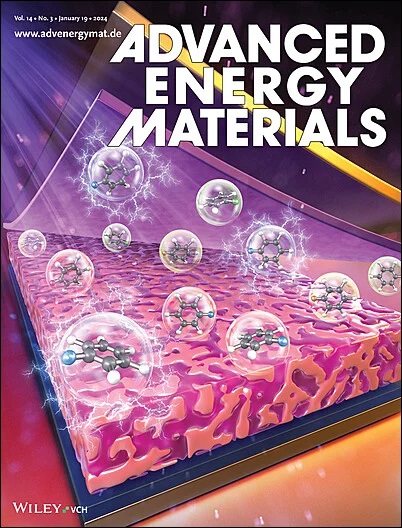Dual Plasmonic Fields Enable High‐Density Hot‐Electron Generation with Stepwise Charge Transfer Directed to Oxygen Reduction Sites for Enhanced Artificial Photosynthesis of H2O2
IF 24.4
1区 材料科学
Q1 CHEMISTRY, PHYSICAL
引用次数: 0
Abstract
Artificial H₂O₂ photosynthesis via plasmonic heterojunction photocatalysts represents a promising route for solar‐to‐chemical energy conversion. However, traditional systems are often limited by inefficient charge separation, inadequate utilization of hot electrons, and non‐specific reaction sites, resulting in suboptimal H₂O₂ production. Here, we present a catalyst architecture that achieves high‐density hot‐electron generation with stepwise charge transfer directed to oxygen reduction sites, boosting H₂O₂ photosynthesis. The catalyst comprises ZnIn₂S₄ (ZIS) nanosheets integrated with two non‐noble plasmonic semiconductors, W双等离子体场能够产生高密度热电子,并逐步向氧还原位点转移,以增强H2O2的人工光合作用
利用等离子体异质结光催化剂进行人工H₂O₂光合作用是一种很有前途的太阳能-化学能转换途径。然而,传统的系统往往受到低效率的电荷分离、热电子利用不足和非特异性反应位点的限制,导致不理想的H₂O₂生成。在这里,我们提出了一种催化剂结构,可以实现高密度热电子生成,并逐步将电荷转移到氧还原位点,从而促进H₂O₂光合作用。催化剂由ZIS纳米片和两种非贵金属等离子体半导体W18O49纳米针和MoO3 - X纳米片组成。这种结构利用局域表面等离子体共振(LSPR)的双位点来放大热电子的产生,同时通过双S - scheme实现顺序电荷迁移,引导电子到还原位点,同时最大限度地减少重组。优化后的双- LSPR -双- S - Scheme (dds)催化剂的H2O2产率在uv -可见光下为51.3µmol g⁻¹min,在可见光下为13.6µmol g⁻¹min。光谱分析(fs - TA, XPS, in - situ DRIFTS)证实了快速的载流子动力学,有效的热电子积累,以及在目标位点形成活性氧中间体(*O₂⁻,*OOH)。理论计算表明,双LSPR增强了局部电场,证实了热电子加速迁移。产生的H₂O₂被进一步评估为实际应用,包括中毒植物的解毒和细菌的灭活,证明其在环境修复方面的潜力。
本文章由计算机程序翻译,如有差异,请以英文原文为准。
求助全文
约1分钟内获得全文
求助全文
来源期刊

Advanced Energy Materials
CHEMISTRY, PHYSICAL-ENERGY & FUELS
CiteScore
41.90
自引率
4.00%
发文量
889
审稿时长
1.4 months
期刊介绍:
Established in 2011, Advanced Energy Materials is an international, interdisciplinary, English-language journal that focuses on materials used in energy harvesting, conversion, and storage. It is regarded as a top-quality journal alongside Advanced Materials, Advanced Functional Materials, and Small.
With a 2022 Impact Factor of 27.8, Advanced Energy Materials is considered a prime source for the best energy-related research. The journal covers a wide range of topics in energy-related research, including organic and inorganic photovoltaics, batteries and supercapacitors, fuel cells, hydrogen generation and storage, thermoelectrics, water splitting and photocatalysis, solar fuels and thermosolar power, magnetocalorics, and piezoelectronics.
The readership of Advanced Energy Materials includes materials scientists, chemists, physicists, and engineers in both academia and industry. The journal is indexed in various databases and collections, such as Advanced Technologies & Aerospace Database, FIZ Karlsruhe, INSPEC (IET), Science Citation Index Expanded, Technology Collection, and Web of Science, among others.
 求助内容:
求助内容: 应助结果提醒方式:
应助结果提醒方式:


